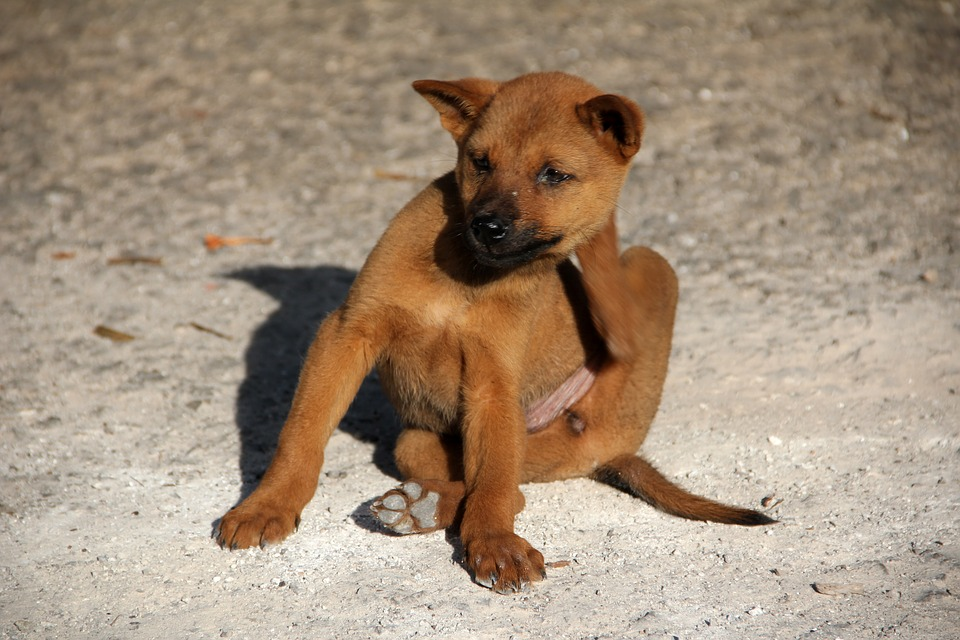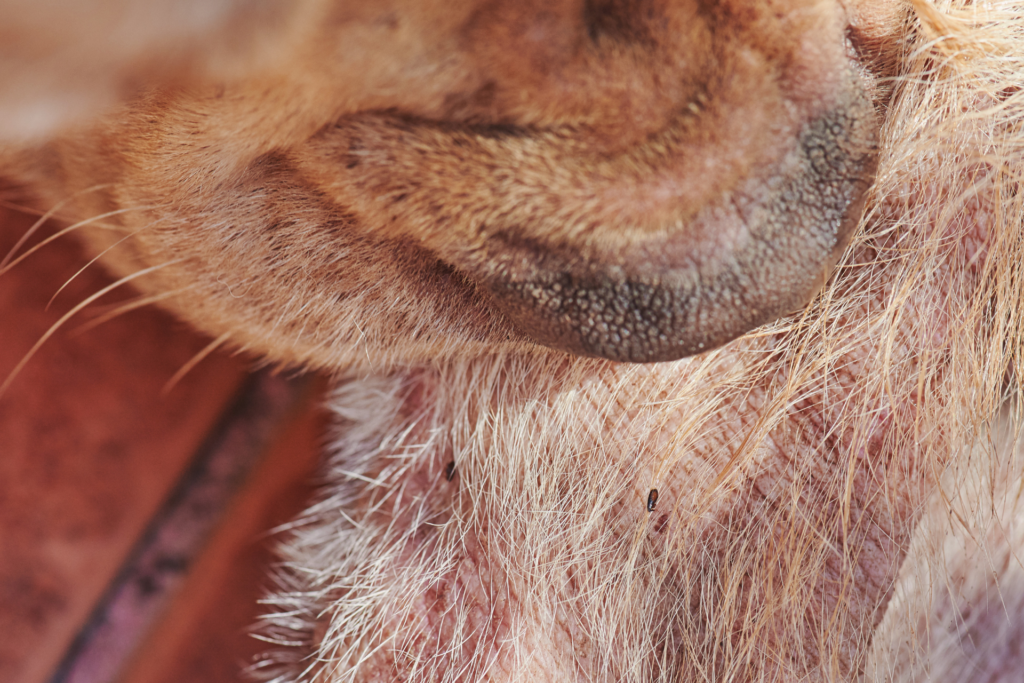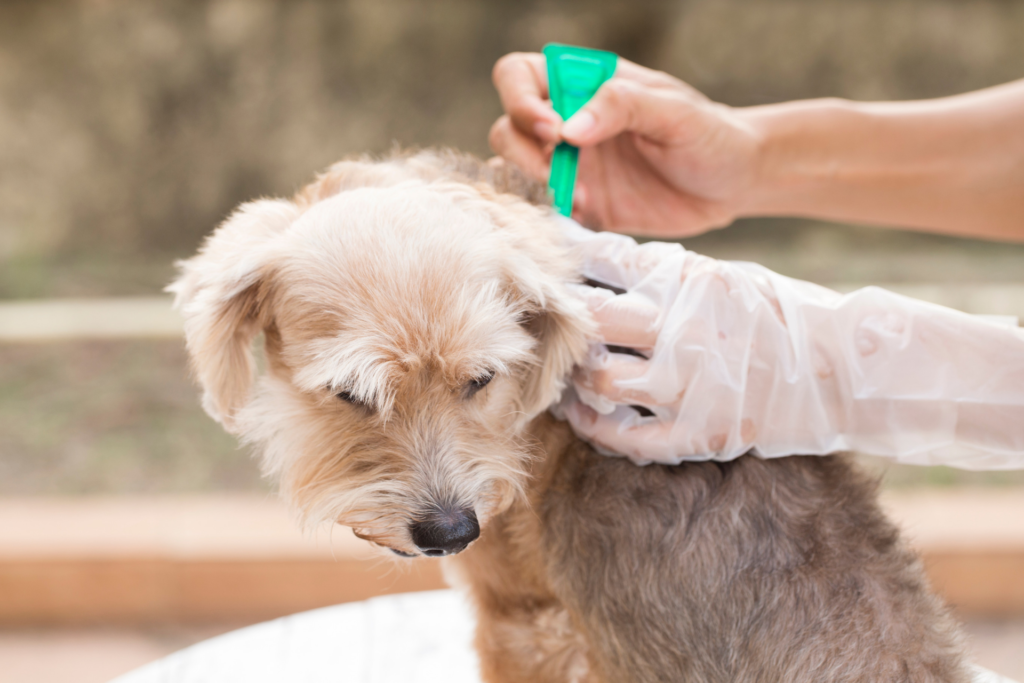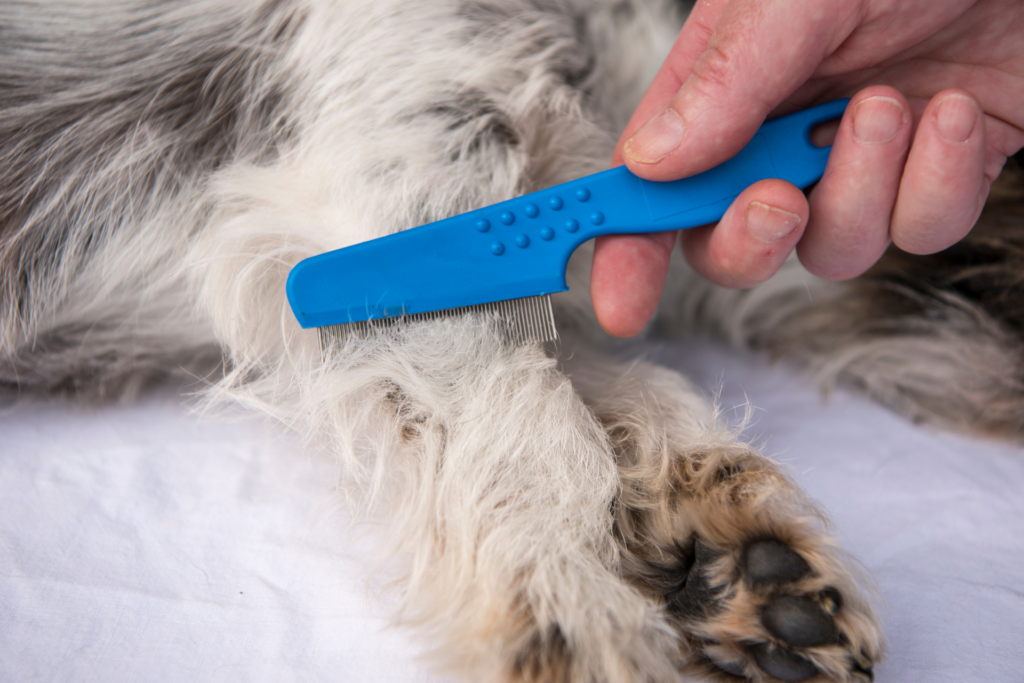The horror has happened: you have found a small black insect on your dog and you think it might be a flea. Whether it turns out to be a flea or not, every pup-parent needs to know how to prevent and get rid of fleas on dogs.
What Are Fleas?
Fleas are small insects (1/16 to 1/8 inch) that feed on the blood of mammals – including your beloved canine.
They have no wings but jump from host to host, laying eggs and chewing on the skin of your pets and their human family members.
Despite their small size, fleas are capable of jumping seven inches high and 13 inches across from one host to another.
Fleas are an issue because not only can they cause terrible itching, skin reactions, and infections, they can also transmit diseases like plague and myxomatosis.
There are over 2,000 varieties of fleas but the most common can all be treated and prevented with the same methods.
Once a flea infestation has taken hold, they can be very difficult to eradicate. In this article, we will discuss what to do if you suspect an infestation and how to prevent such an unhappy event from occurring in the first place.

Where Do Fleas Come From?
Fleas prefer temperatures between 65 and 80 degrees Fahrenheit and humidity levels of 75-80%. As a result, in many places fleas are only an issue during the summer months. If you live somewhere like the southern United States though, fleas can survive all year long.
Dogs can contract fleas from other mammals infested with the small bugs or from the environment.
How To Identify Fleas On Dogs
Unlike other rash-causing organisms like mites, fleas do not burrow into your dogs skin; they are visible on the surface.
Fleas are about the size of a pinhead and dislike light, so your best bet is to look within the fur on your dog’s belly and inner thighs.
The copper to reddish-brown colored fleas have a hard body; if you catch a bug and it easily squishes, it is not a flea.
Even if you don’t see a flea, you can check your dog for flea bites in the form of small red bumps on your dog’s soft belly skin. Fleas also leave “flea dirt” in your dog’s coat. Flea dirt is actually feces that looks like black pepper and will turn red if moistened. The presence of flea bites and flea dirt both indicate the presence of fleas on your dog.
If you still aren’t sure if what you’re seeing is a flea infestation, trap one of the bugs in a jar and bring it to your veterinarian for identification.

Preventing Your Dog From Getting Fleas
The best and most effective method to treat your dog for fleas is to prevent an infestation from ever even occurring. Having your dog on a routine flea preventative is essential to a happy, healthy, itch-free dog.
- Advantage Topical Flea Treatment: This treatment is applied topically to the back of your dog’s neck once a month. The medicated ointment kills adult fleas before they lay eggs and kills larvae before they have a chance to hatch.
- Frontline Plus Flea and Tick Control: Frontline kills flea adults, eggs, and larvae, with the added bonus of killing ticks as well. This topical medicated ointment is also waterproof.
- Bravecto: Bravecto is a chewable flea and tick preventative given once every 3 months. This treatment permeates the fluid under your dog’s skin so that when ticks and fleas bite your dog, they ingest a toxin that kills them. Bravecto is effective for 12 weeks.
- Capstar Flea Treatment: This method is an oral pill administered once a month. This effective flea preventative cannot be washed or rubbed off like a topical treatment.
- Flea Collar: Flea collars are a great complement to other forms of flea prevention but are not very effective alone.
The science and methods for flea control are always changing. Read more about 2019’s best flea and tick treatments for dogs.

What To Do If You Suspect a Flea Infestation
Don’t panic. If you suspect fleas have infiltrated your home there are simple steps to follow to keep the infestation from worsening and to work towards a flea-free home.
Find the Source of the Fleas
Before beginning to treat the fleas you must first identify their source. Here are a few possible sources of the fleas on dogs.
- Your dog: Sometimes your dog has picked up fleas outside and, if caught early enough, he or she may be the only one affected.
- Carpet: Consider whether your carpet or any other fabric items could have brought fleas into your home.
Wash Before You Treat
Before you pursue any treatment for your house or dog, give everything a good washing. This means deep clean any surface your dog lays on: their bed, the carpet, blankets, towels, etc. You should also wash your fabrics (preferably in very hot water), vacuum the floor, couches, chairs, etc and empty the vacuum bag outside. Clean your hard surfaces like floors, counters, tables, and anything else you can think of.

Treating Your House For Fleas
There are both chemical and natural ways to treat flea infestations in your home. Chemical methods tend to be faster and more popular with homeowners. Here are a few methods to treat your home.
- Sticky Flea Pads: Similar to flypaper, these sticky pads are usually attached to an electronic trap that you plug in near an infested location. Fleas are attracted to the trap and get stuck to the paper. This can take several weeks as the traps must be left out long enough to make sure all fleas are captured.
- Boric Acid: Products with boric acid can be used to kill fleas and are non-toxic to both people and animals. Sprinkle this product on the carpet and use a broom to work it into the fibers, then vacuum up the excess powder. Vacuum regularly thereafter to remove dead fleas from the carpet.
- Nylar: Nylar is an insect growth inhibitor, a chemical that prevents fleas from maturing from juveniles to adults. This prevents the fleas from breeding. Nylar can be sprayed on furniture and carpets and the residue can remain active for 3-4 months.
- Professional pest control: Since one female flea alone can lay 600 eggs in her lifetime, it is important that you make sure to kill all the fleas in your home. A professional pest control service can guarantee their work, offering a refund or second treatment if the first treatment is not effective. You may even find some pest control companies that use natural methods to kill fleas if that is your preference.
Treating Your Dog For Fleas
Now that you’ve treated your house and belongings, it’s time to get these pesky fleas off your dog. Though there is information on some at-home remedies for getting rid of fleas on your dog, they have not been proven to work. Here are a few tried and true methods for de-fleaing your pooch.
- Medicated bath: Giving your dog a bath with an over-the-counter medicated flea shampoo specially formulated for fleas will terminate the problem. You could also take them to your veterinarian for a stronger flea bath. If you prefer not to use chemicals, diluted dawn dish soap can act as an alternative.
- Flea comb: Another non-chemical alternative is a flea comb. Flea combs have very fine teeth that trap fleas as you brush your dog. These can be especially useful for dogs with long hair. Place newspaper under your dog then comb through their fur with the flea comb. The newspaper will catch any fleas that fall off your dog as you comb them.

There are many avenues for flea treatment and prevention. Whether you prefer natural or chemical methods, consult with your veterinarian and ask any questions you may have about how best to keep your dog thriving and flea-free.
